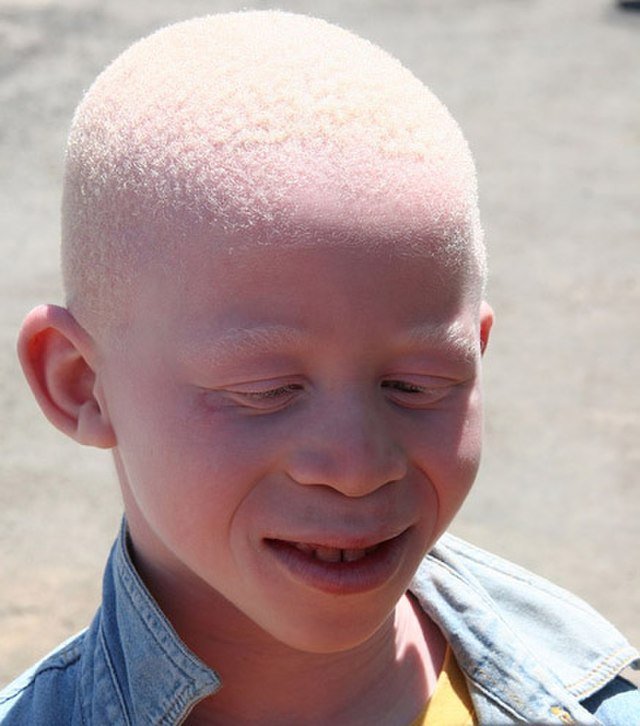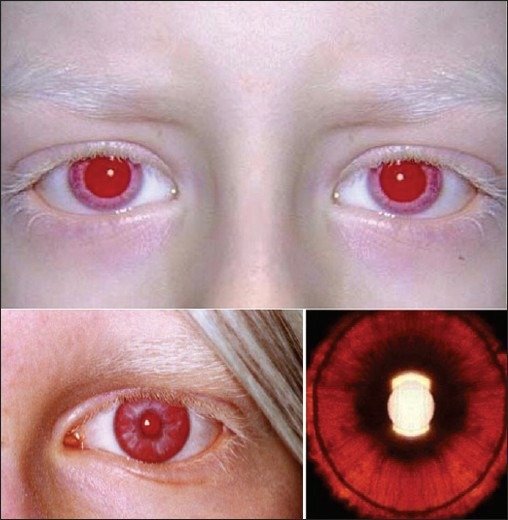Albinism
Content of This Page
1- Introduction
2- Causes
3- Symptoms
4- Investigations & Lab Results
5- Complications
6- Treatment
Introduction
Albinism is a group of rare, inherited genetic disorders characterized by a reduction or complete absence of melanin, the pigment responsible for coloring the skin, hair, and eyes. This deficiency results from mutations affecting melanin production, most commonly in the enzyme tyrosinase, which plays a key role in the synthesis of melanin in melanocytes. Albinism affects individuals of all ethnic backgrounds and can vary in severity.
There are two major types:
Oculocutaneous albinism (OCA): Affects the skin, hair, and eyes.
Ocular albinism (OA): Primarily affects the eyes, with minimal or no skin and hair involvement

Causes
1. Genetic Mutations Affecting Melanin Synthesis
Tyrosinase gene (TYR):
Mutations lead to Oculocutaneous Albinism type 1 (OCA1)
Tyrosinase is crucial for melanin production.
OCA2 gene (P gene):
Most common type globally (especially in sub-Saharan Africa)
Causes partial melanin production.
Other genes involved:
TYRP1, SLC45A2, SLC24A5, HPS1–HPS10 (in Hermansky–Pudlak syndrome)
Each causes different subtypes of OCA or syndromic albinism.
2. Inheritance Patterns
Autosomal recessive inheritance:
Most forms of Oculocutaneous Albinism (both parents must be carriers)
X-linked inheritance:
Ocular Albinism (OA1), primarily affects males
3. Syndromic Forms of Albinism
Hermansky–Pudlak Syndrome (HPS):
Albinism with bleeding disorders and organ involvement
Chediak–Higashi Syndrome:
Albinism with immune deficiency and neurological issues

Symptoms
1. Skin Symptoms
-
Very light or pale skin at birth
-
Increased sensitivity to sun (photosensitivity)
-
High risk of sunburn with minimal sun exposure
-
Tendency to develop freckles, moles, and solar keratoses
-
Increased risk of skin cancer, especially squamous cell carcinoma
2. Hair Symptoms
-
White or very light blond hair in individuals of all ethnicities
-
Hair color may darken slightly with age but remains lighter than average
-
Some forms may allow limited melanin production, leading to light brown or yellow hair
3. Eye Symptoms (Ocular Features)
-
Light blue to light brown irises (may appear red in some lighting due to lack of pigment)
-
Photophobia (sensitivity to light)
-
Nystagmus (involuntary eye movements)
-
Strabismus (crossed or misaligned eyes)
-
Reduced visual acuity (blurred vision, near or far)
-
Foveal hypoplasia (underdevelopment of the central retina)
-
Misrouting of optic nerves (abnormal connections between eyes and brain)
4. Other Features
-
Normal intelligence and development
-
In syndromic forms (e.g., Hermansky–Pudlak syndrome):
-
Bleeding tendency
-
Lung or bowel disease
-
Immune dysfunction
-
Investigations & Lab Results
1. Clinical Evaluation
Skin, hair, and eye pigmentation assessment
Ophthalmologic examination:
Checks for nystagmus, reduced visual acuity, foveal hypoplasia, and optic nerve misrouting
2. Eye-Specific Tests
Visual acuity testing – often reduced from birth
Slit-lamp examination – to examine the iris and detect translucency
Electroretinography (ERG) – may show reduced retinal function
Visual Evoked Potential (VEP) – detects abnormal optic nerve pathways
Helps distinguish albinism from other causes of poor vision
3. Genetic Testing
Confirms diagnosis by identifying mutations in genes like:
TYR, OCA2, SLC45A2, TYRP1, etc.
Helps classify the specific type of albinism
Can identify carrier status in parents or siblings
4. Tests for Syndromic Albinism
If a syndromic form like Hermansky–Pudlak Syndrome is suspected:
Platelet function tests – for bleeding disorders
Chest imaging – to assess pulmonary fibrosis
Electron microscopy of platelets – shows absent dense bodies
Pulmonary function tests (PFTs) – if lung involvement suspected
5. Skin Biopsy (Rarely Needed)
May confirm absence of melanin in melanocytes
Rarely done if clinical and genetic findings are conclusive
Complications
1. Ocular Complications
Reduced visual acuity (may be severe or legally blind in some cases)
Photophobia (sensitivity to light)
Nystagmus (involuntary eye movement)
Strabismus (misalignment of the eyes)
Foveal hypoplasia (underdeveloped central retina)
Impaired depth perception due to optic nerve misrouting
Increased risk of functional vision impairment, impacting learning and daily activities
2. Skin Complications
Severe sunburn from minimal sun exposure due to lack of melanin protection
High risk of skin cancers, especially:
Squamous cell carcinoma
Basal cell carcinoma
(Less commonly) melanoma
Premature skin aging due to cumulative UV exposure
3. Psychosocial and Social Complications
Social stigma and discrimination, especially in communities where albinism is misunderstood
Psychological stress, anxiety, or depression
Educational challenges due to vision impairment
Safety concerns in some regions (e.g., physical violence or exploitation in parts of Africa)
4. Syndromic Complications (in types like Hermansky–Pudlak Syndrome)
Bleeding disorders (due to platelet dysfunction)
Pulmonary fibrosis (progressive and potentially fatal lung disease)
Granulomatous colitis (inflammatory bowel symptoms)
Immune deficiency (in Chediak–Higashi syndrome)
Neurological deterioration in severe cases
Treatment
1. Ocular Complications
Reduced visual acuity (may be severe or legally blind in some cases)
Photophobia (sensitivity to light)
Nystagmus (involuntary eye movement)
Strabismus (misalignment of the eyes)
Foveal hypoplasia (underdeveloped central retina)
Impaired depth perception due to optic nerve misrouting
Increased risk of functional vision impairment, impacting learning and daily activities
2. Skin Complications
Severe sunburn from minimal sun exposure due to lack of melanin protection
High risk of skin cancers, especially:
Squamous cell carcinoma
Basal cell carcinoma
(Less commonly) melanoma
Premature skin aging due to cumulative UV exposure
3. Psychosocial and Social Complications
Social stigma and discrimination, especially in communities where albinism is misunderstood
Psychological stress, anxiety, or depression
Educational challenges due to vision impairment
Safety concerns in some regions (e.g., physical violence or exploitation in parts of Africa)
4. Syndromic Complications (in types like Hermansky–Pudlak Syndrome)
Bleeding disorders (due to platelet dysfunction)
Pulmonary fibrosis (progressive and potentially fatal lung disease)
Granulomatous colitis (inflammatory bowel symptoms)
Immune deficiency (in Chediak–Higashi syndrome)
Neurological deterioration in severe cases